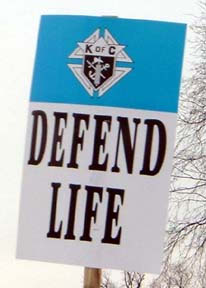Early efforts
From the founding of the order to roughly the time of the First World War, "the Order's goals were most visibly expressed in its assertion of the social legitimacy and patriotic loyalty of Catholic immigrants." This opposition to immigration restrictionists would continue through the middle of the 20th century
In the years prior to World War I, Canadian Knights established an immigrant aid bureau. After the war, and with the Catholic Women's League, they promoted a "Canadianization of the Newcomer" program. The Knights have also promoted the idea that being a good Catholic can be reconciled with being a good Canadian, and have helped Catholic immigrants assimilate into wider society.
In 1921, Edward F. McSweeney, a former Assistant Commissioner of Immigration at Ellis Island and pro-immigrant activist and author, set up the Knights of Columbus Historical Commission to more clearly present the role of Catholic immigrants in particular in the founding and history of the United States. The Commission published the works of intellectuals including George Schuster, Samuel Flagg Bemis, Allan Nevins, and W. E. B. Du Bois.
The Knights called the tendency to set up a caste system based on when your ancestors arrived in the country "a travesty of democracy." James Malone, then-Kansas State Deputy, argued that those who claimed that immigrants and Catholics were inferior to native-born Americans and protestants were "bigots."
At the request of the Jewish War Veterans of the United States of America, Supreme Knight Martin Carmody wrote to Franklin D. Roosevelt in 1938 to support Jewish refugees seeking refuge in Palestine.
21st century
On 9 April 2006 the board of directors commented on the "U.S. immigration policy [which] has become an intensely debated and divisive issue on both sides of the border between the U.S. and Mexico." [71] [72] They called
upon the President and the U.S. Congress to agree upon immigration legislation that not only gains control over the process of immigration, but also rejects any effort to criminalize those who provide humanitarian assistance to illegal immigrants, and provides these immigrants an avenue by which they can emerge from the shadows of society and seek legal residency and citizenship in the U.S. [71]
During the 2008 International Eucharistic Congress, a donation was made by the Order in Canada to Marc Ouellet's foundation to support long-term programs to aid immigrants and refugees. [73]
At the Supreme Convention in 2011, Los Angeles Archbishop José Gómez criticized the United States' immigration policy as not being "worthy of our national character," [74] and told the delegates to approach the immigration issue as Catholics, not through political affiliation. [74] "Our perspective on this issue will change if you begin to see these 'illegals' for who they really are—mothers and fathers, sons and daughters—not much different from yourselves," Gomez said. [74]
In 2013, at the 131st Supreme Convention, Archbishop Gustavo Garcia-Siller of San Antonio, Texas, the site of the convention, quoted Anderson in saying that the city was special because the city's history of "evangelization, immigration, and the quest for freedom." [75] He called on the Knights to bring the light of the Gospel to the "desolate places" such as immigrant detention centers. [75]
Also at the 2013 convention, Supreme Chaplain William Lori said that the Knights' mission in regards to immigration is "definitely growing." [75] He cited their involvement in Ecclesia en America, a summit held in the Vatican in 2012, as a way they protect, love and help immigrants. [75] The Knights see the issue, according to Lori, as "a partnership of the North and South Church." [75] He said the order was working to enact "immigration laws that are truly just, and truly merciful." [75]
In 2016, the Knights provided funding to the dioceses of Ciudad Juárez and El Paso to facilitate Pope Francis' visit to the US-Mexican border which highlighted the plight of migrants from majority-Catholic Mexico, and the need therefore to work for "just immigration laws." [76]
At the 2017 convention, Cardinal Daniel DiNardo of Galveston-Houston, president of the U.S. bishops’ conference, said that Christ teaches that "there is no more boundary when it comes to 'who are you neighbor to?'" [77] DiNardo added that the Knights live this teaching by helping anyone in need, including immigrants, refugees, and Christians displaced from their homes. [77]
At the 136th Supreme Convention in 2018, the Order adopted a resolution criticizing the Trump administration family separation policy. [78] The Supreme Council called on the administration to "equitably balance the legitimate rights of persons to emigrate in order to seek better lives for themselves and their children, with the duty of governments to control migration into their countries so that immigration policy serves the common good." [78]
The Order has also supported the creation of by the Melkite Greek Catholic Church of an Arab Christian Council within Canada as adding "new meaning to the international fraternal organization’s outreach and support of immigrant communities." [79] The council is largely made up of first-generation Canadians from Palestine, Syria, Jordan, Lebanon, Egypt, and Iraq. [79]



